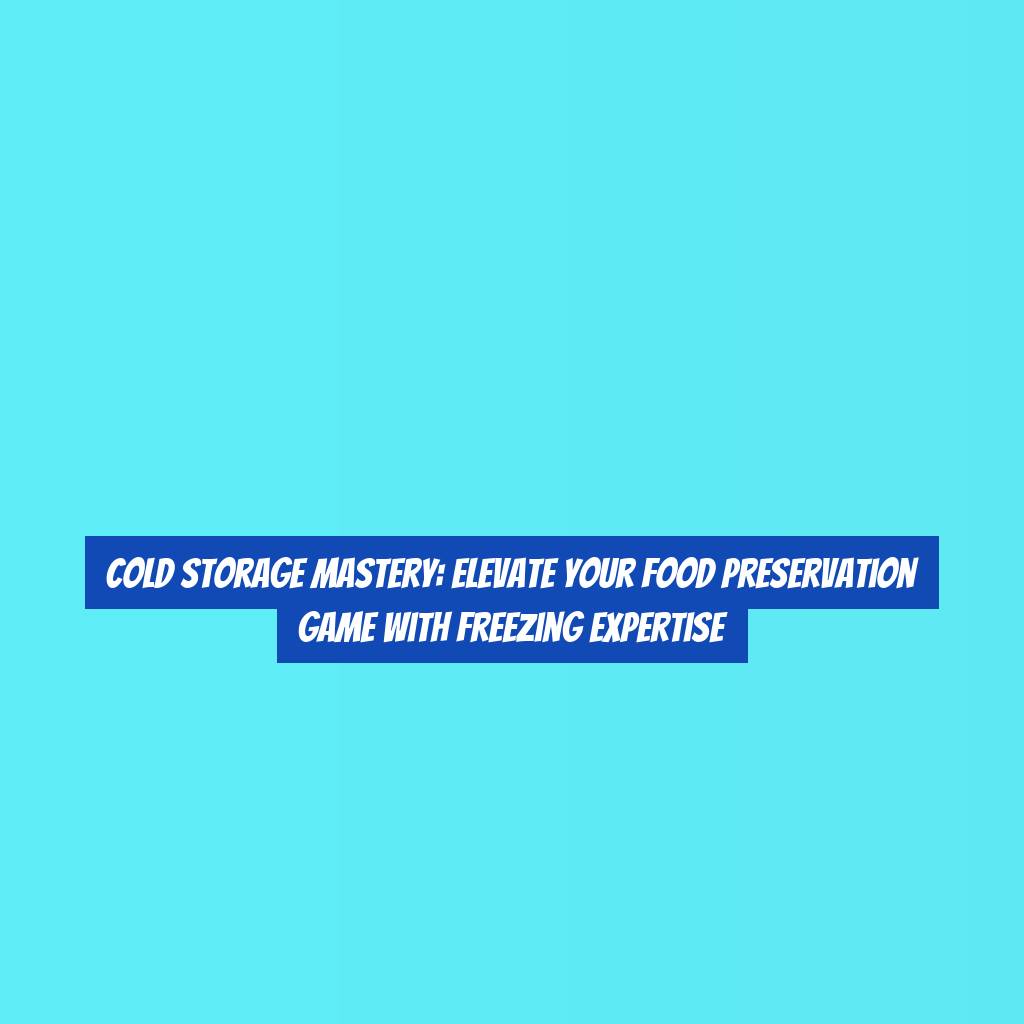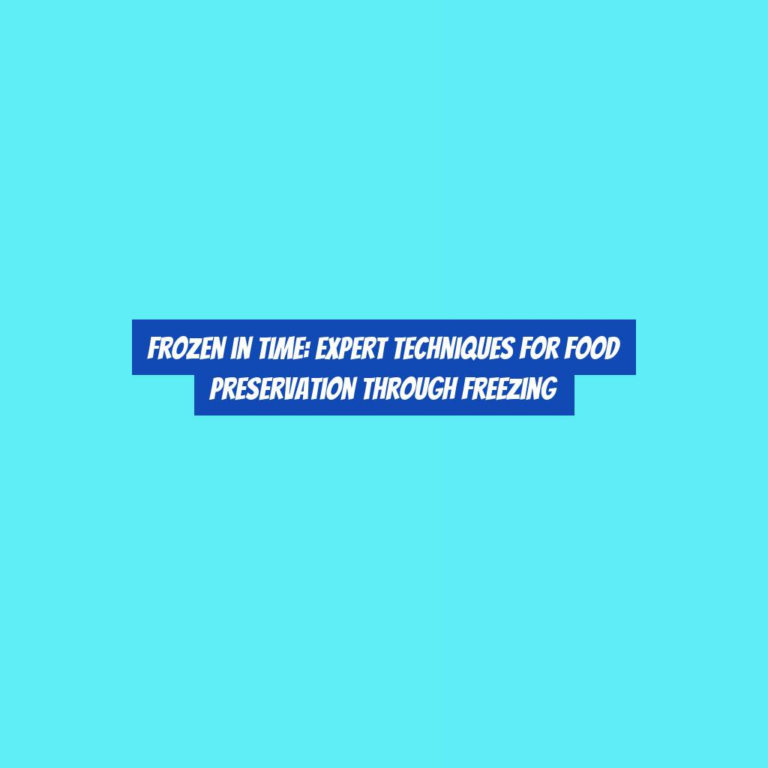Cold Storage Mastery: Elevate Your Food Preservation Game with Freezing Expertise
In the world of culinary preservation, the freezer stands as a symbol of untapped potential. It holds the power to extend the lifespan of your favorite ingredients, elevate the flavors of your meals, and streamline your meal prep routine.
But simply tossing items into the freezer wonG??t do. To truly master the art of cold storage, you must delve into the intricacies of freezing.
As you navigate the nuances of freezing expertise, youG??ll uncover the secrets to preserving food at its peak, reducing waste, and unlocking a world of culinary possibilities.
Understanding Freezing Basics
To freeze food effectively, itG??s crucial to understand the basics of how freezing works and the impact it has on the quality of the food. When you place food in the freezer, the water content inside the food forms ice crystals. The speed at which these crystals form and their size greatly affects the foodG??s texture and quality once itG??s thawed.
Rapid freezing, achieved by setting the freezer at its coldest setting, results in smaller ice crystals, which cause less damage to the foodG??s cellular structure. This preserves the foodG??s texture and flavor more effectively. On the other hand, slow freezing, often caused by overloading the freezer or keeping it at a higher temperature, forms larger ice crystals that can rupture cell walls, leading to a loss of texture and flavor.
Another important aspect to consider is packaging. Proper packaging helps maintain the quality of the food. It prevents moisture loss, which can lead to freezer burn, and protects the food from absorbing other odors in the freezer. Therefore, using airtight, moisture-proof packaging such as freezer bags or containers is essential for preserving the quality of frozen food.
Understanding these basics will help you master the art of freezing and ensure that your frozen food retains its quality and flavor when itG??s time to thaw and enjoy it.
Choosing the Right Containers
Consider using a variety of airtight, moisture-proof containers to preserve the quality of your frozen food. The right containers can make a significant difference in maintaining the flavor and texture of your frozen items. Here are some tips to help you choose the best containers for freezing your food:
-
Plastic Containers: Look for containers specifically designed for freezing, as theyG??re durable and less likely to crack in the freezer. Make sure they have a tight-fitting lid to prevent air from seeping in and causing freezer burn.
-
Freezer Bags: Opt for high-quality, thick freezer bags that are resistant to tears and punctures. Squeeze out excess air before sealing the bag to minimize the risk of freezer burn.
-
Vacuum-Sealed Bags: Consider investing in a vacuum sealer to remove air from the bags before sealing them. This method can help preserve the quality of your frozen food for longer periods.
Optimizing Freezer Organization
Maximizing the use of available space in your freezer can help you maintain an organized and efficient system for storing your frozen items. Start by grouping similar items together, such as placing meats in one section and frozen vegetables in another.
Use stackable containers to make the most of the vertical space in your freezer. Additionally, consider investing in freezer baskets or bins to keep smaller items organized and prevent them from getting lost in the depths of your freezer. Labeling your containers and shelves can also help you quickly locate specific items and prevent food from getting lost and ultimately wasted.
When organizing your freezer, keep frequently used items within easy reach, and less frequently used items towards the back. Remember to regularly declutter your freezer by removing expired items and taking inventory of what you have.
Mastering Freezing Techniques
When freezing various items, ensure that theyG??re properly prepared and packaged to maintain their quality and freshness.
First, make sure to remove as much air as possible from the packaging to prevent freezer burn. Air-tight containers or vacuum-sealed bags are excellent choices for this purpose.
Second, label each item with the date of freezing to keep track of its freshness. This way, you can easily identify how long an item has been in the freezer and maintain a first-in, first-out system.
Lastly, itG??s important to freeze items at their peak freshness to preserve their flavor and nutritional value. Blanching vegetables before freezing and using freezer-safe containers for liquids can help retain the quality of the food.
Extending Shelf Life With Freezing
To further enhance the quality and longevity of your frozen items, itG??s essential to understand how freezing can effectively extend their shelf life. Freezing halts the growth of microorganisms and slows down enzymatic reactions, preserving the foodG??s quality. However, proper packaging is crucial to prevent freezer burn, which can affect taste and texture. Use airtight containers or heavy-duty freezer bags, removing as much air as possible before sealing. Label items with the date of freezing to ensure timely consumption.
ItG??s important to know the optimal freezing times for different foods. Most fruits and vegetables maintain their best quality for 8-12 months when properly frozen. Meats can be stored for 3-12 months, while cooked dishes maintain their quality for 2-3 months. Keep in mind that while freezing extends shelf life, it doesnG??t improve the quality of the food. So, freeze items at their peak freshness.
Regularly organizing and rotating items in your freezer helps prevent food from getting lost and forgotten. This practice ensures that you use items before they exceed their recommended storage time. By mastering freezing techniques and understanding how it extends shelf life, you can make the most of your frozen foods and reduce waste.
Conclusion
Now that youG??ve mastered the art of cold storage, you can elevate your food preservation game with freezing expertise. By understanding freezing basics, choosing the right containers, optimizing freezer organization, and mastering freezing techniques, you can extend the shelf life of your food and reduce waste.
With these skills, youG??ll be able to enjoy fresh, frozen foods for longer periods of time, saving both time and money in the process.
Keep freezing and preserving!

